Identifying and Trading with Trends on Quotex: A Comprehensive Guide
Learn how to spot trends on Quotex and understand uptrends, downtrends, and sideways movements. Incorporate this knowledge into your trading strategy for better success.
You might have encountered familiar sayings like “The trend is your friend” and “Follow the trend.” But what exactly is a trend? In its simplest form, a trend refers to the market’s direction. From a technical perspective, it represents the direction in which consecutive peaks form.
Below, you can learn how to identify and incorporate these trends into your trading for a better success rate.
WHAT IS QUOTEX?
Quotex is an internet-based brokerage company that enables trading in various asset classes, such as currency pairs, stock indices, cryptocurrencies, and commodities. They provide risk-free demo accounts, allowing you to practice trading strategies in a safe market environment. When you feel ready to start trading, you can easily open an account with multiple deposit choices without any deposit fees. The minimum deposit required is as low as 10 USD.
Additionally, Quotex offers attractive bonuses of up to 35%. The company prides itself on providing sleek and user-friendly trading platforms and active customer support available round-the-clock, ready to assist you anytime.

Basics of Trend Identification
Trend identification is a fundamental concept in technical analysis, a method used to analyze financial markets and make trading decisions based on historical price data. Here are some pointers you can use to identify trends.
Uptrend: An uptrend involves a price increase over a long period. In an uptrend, each subsequent high and low (peaks and valleys) is greater than the previous. You can draw a sloping line that connects the higher lows characteristic of an uptrend.
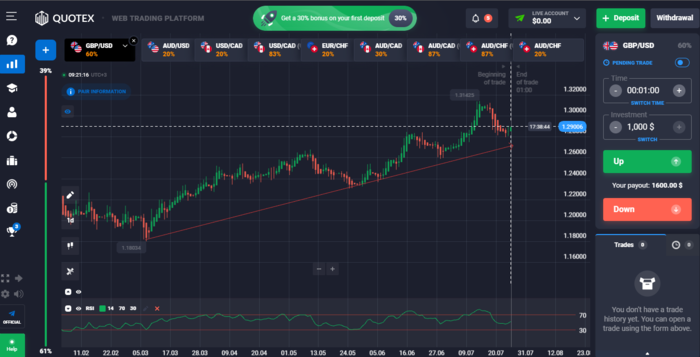
Downtrend: A downtrend involves the price of an asset decreasing over time. Each subsequent peak and valley is less significant in a downtrend than the previous one. To identify the downtrend, you can draw a sloping line that connects the lower highs.
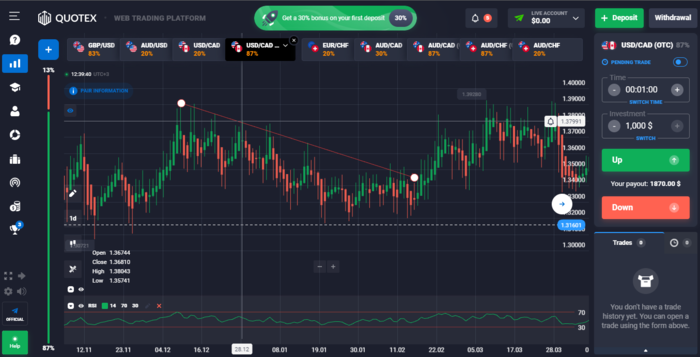
Sideways trend: In a lateral movement, the asset’s price is confined to a specific range and does not have a defined up or down direction. The price consistently moves between particular support and resistance levels, creating a horizontal barrier.
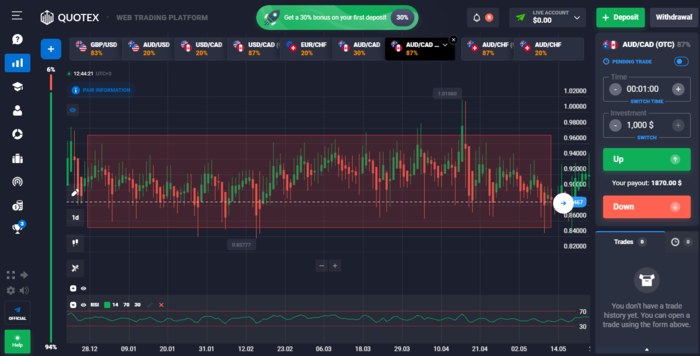
PRICE ACTION ANALYSIS
Price action refers to the continuous change in the price of a financial asset represented on a chart over a specific period. It is the foundation for all technical analyses conducted on stocks, commodities, or other assets on Quotex.
Numerous short-term traders heavily depend on price action and its patterns and trends to guide their trading choices. As a methodology, technical analysis stems from price action, which involves utilizing historical prices in various calculations to facilitate informed trading decisions.
Identifying Consolidation Patterns
You can observe three concurrent characteristics on a price chart to identify if an asset is undergoing consolidation:
- First, check whether the asset has displayed well-defined and consistent support and resistance levels, resembling a flag continuation pattern.
- Second, ensure it has exhibited a narrow trading range. However, remember that not all stocks and securities have the same level of volatility, so you must assess trading ranges relatively.
- Last, look for a relatively low level of trading volume without significant spikes.
Consolidation in and of itself is neither positive nor negative. At times, it follows a healthy price movement. Being cautious about potential overbought or oversold positions, traders might seek to stabilize fluctuations before a new trend emerges.

Identifying Breakouts and Reversals
A breakout occurs when an asset price moves beyond a clearly defined support or resistance level, accompanied by higher trading volume. You can capitalize on this movement by taking a long position when the stock price breaks above resistance or a short position when it breaks below support. After surpassing the price barrier, volatility rises, and prices move toward the breakout.
Breakouts are highly valued as a trading strategy because they are the initial trigger for increased volatility and significant price swings and often lead to major price trends in various situations.
To identify breakouts, you must first identify support and resistance levels on a chart. These levels are easy to identify. Study your chart and locate price levels where the price has reversed before, either to the upside or the downside. These are the levels of support and resistance.
Monitor as the price approaches these levels. A volatility oscillator like the Chaikin would be in your best interest. Monitor the volatility of the market as the price approaches these levels. High volatility indicates a breakout, while low volatility indicates a false breakout.

Analyzing Price Channels and Trends
The concept of a price channel pertains to a chart pattern where two parallel lines confine an asset’s price movement. This channel can be horizontal, ascending, or descending, depending on the trend’s direction.
Traders who employ technical analysis use price channels to assess the momentum and trajectory of an asset’s price action, enabling them to identify potential trading ranges.
Correctly identifying price channels offers you several ways to benefit. The most advantageous approach to capitalize on potential gains arises when the asset adheres to a well-defined price channel path, strategically employing long and short positions. Consider the following guidelines.
Uptrend: In an uptrending market, you may opt to hold your positions near the upper boundary of the price channel, anticipating a breakout that could lead to a substantial price surge. However, once the asset approaches the upper trendline and shows signs of staying within the price channel, you may consider selling the asset or taking a short position to exploit potential price retracements.
Downtrend: During a downtrend, consider shorting the asset near the upper bound of the price channel and taking an even deeper short position once a breakout is confirmed. If you believe that the price action will remain within the confines of the price channel, you might go against the trend and take a long position to maximize potential profits.
In summary, correctly identifying price channels allows you to strategically position yourself by combining long and short positions based on the trend direction and the asset’s behavior within the delineated price channel. This approach can enhance the chances of profiting from price movements in the market.
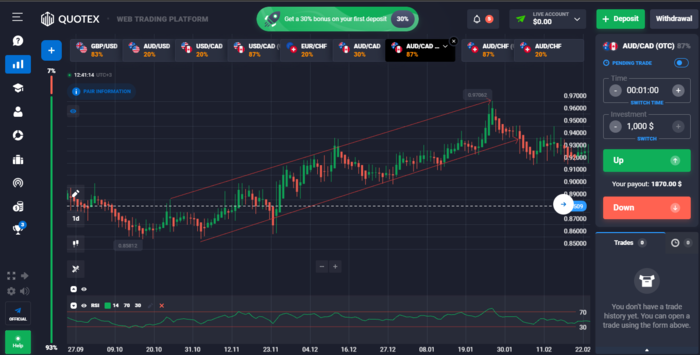
TECHNICAL INDICATORS
Technical indicators are signals derived from an asset or contract’s price, volume, or open interest, based on patterns or heuristics. Traders who employ technical analysis utilize these indicators to study past data and make predictions about future price movements.
Some technical indicators in Quotex include the Relative Strength Index (RSI), stochastics, and Average Directional Movement Index (ADX).
Let’s look at how you can use these indicators to identify trends.
Moving Averages
Moving averages are widely used technical indicators in the stock market. They are derived by adding up the closing prices of an asset over a specific number of periods and then dividing the total by the number of periods. The resulting moving average is a line chart overlaid on the stock’s price movement.
Once the moving average is calculated and plotted, it becomes a valuable tool for visually identifying trends. If the moving average is on an upward trajectory, it suggests that the stock is experiencing an uptrend. Conversely, a declining moving average indicates a stock price downtrend. This indicator proves helpful for investors seeking to spot trends and potentially enhance their profits.
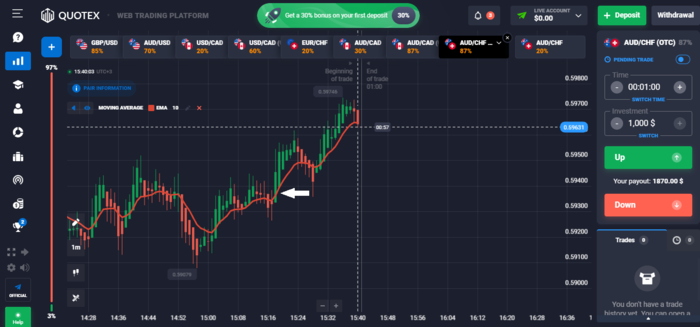
Relative Strength Index (RSI)
You can consider a trend more vital when RSI confirms it. Positive momentum is prevalent in an uptrend, with the RSI staying in the higher range. This range is typically above 50. Negative momentum is commonplace in a downtrend, with the RSI remaining lower. This range is usually below 50.
An oversold RSI reading (typically below 30) during a downtrend may suggest that the asset is undervalued and could lead to a trend reversal to the upside.
Conversely, in an uptrend, if the RSI reaches overbought levels (typically above 70), it may imply that the asset’s price has become too high, signaling a potential trend reversal to the downside.
Average Directional Movement Index (ADX)
ADX values help to interpret the strength of a trend. Values above 25 indicate a strong trend, while values below 25 suggest a weak or non-existent trend. Traders can use these values to determine if they should enter or exit trades.
A rising ADX value may indicate an increasing trend strength, while a falling ADX value may suggest a weakening trend.
PRICE LEVEL ANALYSIS
Price level analysis is pivotal to online trading on Quotex. Below, you can see how to analyze some of these levels.
Support and Resistance Levels
In a downtrend, prices decrease due to an oversupply compared to demand. As prices drop, they become more attractive to potential buyers, and when demand matches supply, a level of “support” forms, causing the price decline to halt and potentially reverse. Support can appear as a specific price level or a range where buyers step in to make purchases.
On the other hand, “resistance” is the opposite of support and occurs in an uptrend when demand exceeds supply, driving prices upward. However, as prices rise, there comes a point when selling pressure outweighs buying interest, leading to resistance. This resistance level can be a specific price or a broader zone on a price chart.
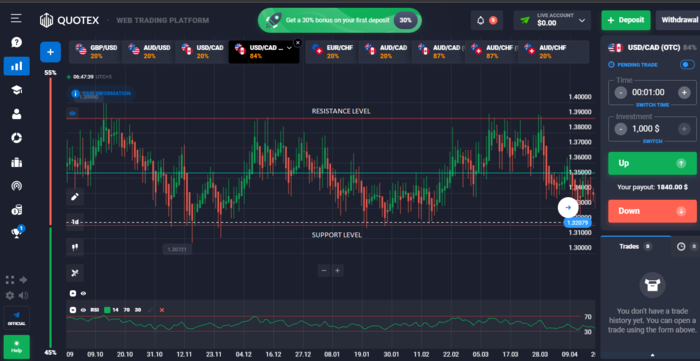
Trend Continuation Signals
Continuation patterns are a type of chart pattern found during an ongoing trend, creating temporary pauses in price movement. When these patterns occur, the trend will likely resume once the pattern is complete.
However, experienced traders understand that the pattern is only partially reliable for predicting future prices. You can find continuation patterns in various time frames, including triangles, flags, pennants, and rectangles.
Retracement Patterns
Before resuming its original trend, retracement patterns happen when a financial asset’s price temporarily moves against the direction of the prevailing trend. Here are some examples of these patterns.
in the head and shoulders pattern, a price breakdown often occurs after a retracement back to the neckline following the formation of the right shoulder. This pattern involves three peaks, where the middle peak, also known as the head, is higher than the other two peaks, called the shoulders. A neckline connects the lows between the peaks.
A double top happens when the price attempts to break through a resistance level twice but is unsuccessful. On the contrary, a double bottom occurs when the price tries to dip below a support level twice but fails. Typically, there is a retracement between the two high or low points.
TRADING STRATEGY DEVELOPMENT
To develop a proper trading strategy, follow these steps.
- Describe your objectives: Consider your financial goals, risk tolerance, and the time frame you will trade. Are you attempting a short- or long-term approach? Understanding your goals will direct your course to trade.
- Select a style of trade: Choose a style of trade that aligns with your personality and lifestyle. Common approaches to trading include day trading, swing trading, position trading, and scalping.
- Create entry and exit conditions: Describe the specifics of how to enter and exit the trade lucidly based on your chosen analysis method. This process may necessitate the identification of specific chart patterns, technical indicators, or fundamental triggers.
- Risk management: Decide how much risk you want to take on each transaction (the risk per transaction) and place stop-loss orders to prevent potential loss. The management of risk is essential to preserving capital and managing declines.
BOTTOM LINE
Trends are an essential part of online trading. You can use various technical indicators to identify these trends for incorporation into your trading strategy.



